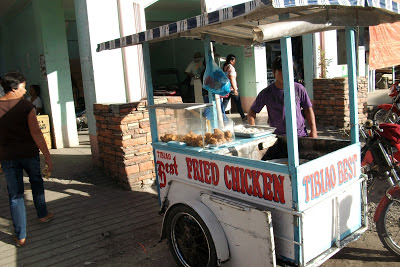The street we live on is about 120 yards long. It begins at the main highway (a two-lane, paved, 20-foot wide road) and extends past a handful of houses, including our place, to end at the Malabor Elementary School. Mostly we smile and wave at neighbors, but other than "good morning" it seems like everyone on the street stays too busy for much conversation. But it might be of some interest for you to see what the nearby area looks like, so I'll put up some photos:
I'll start with our house, which also appeared in an early blog-posting. It
is the typical concrete-block of this area, "efficiency size," and has 2 bed-
rooms, kitchen, living room, bath and an outdoor patio-kitchen which gets
lots of use. The "new house" nearly completed is 40 feet to the left of this,
on the other side of our lot. It is the same size, different layout inside;
that's what will fit onto the space we have. The bamboo "porch-room" is
between our two houses.
As we began work on our new place, the neighbors were having 6
concrete posts poured, 4 of which went through their well-worn
bamboo house. Then, a roof was built over the old house, and walls
built to enclose the new area while the old house was being torn down.
The result was a nice-looking half-concrete bungalow (upper walls are
frame and plywood), with louver-glass windows. Photos of houses are
often difficult because of fences and foliage. There is NO financing in
this area so everyone must build to suit their means.
often difficult because of fences and foliage. There is NO financing in
this area so everyone must build to suit their means.
The house on our other side has had an extensive 2- story addition
in-progress for quite awhile. Their lot is concrete-walled; we wave
if we pass each other but haven't really "met" them.
At the end of the road is the school. No classes today so the gate is
closed. Most weekdays there is a constant stream of foot-traffic and
tricycles moving to and from the school. Here you can see that our
concrete roadway is 8-feet wide, and peoples' fences on both sides are
about 16- feet apart. Note the fancy concrete-arch fence to the left.
tricycles moving to and from the school. Here you can see that our
concrete roadway is 8-feet wide, and peoples' fences on both sides are
about 16- feet apart. Note the fancy concrete-arch fence to the left.

This house is directly across the street from us. The owner has an
upholstery business which he works in some of the patio-like space
added-on to the main concrete house.
This house is opposite our new construction. It was built very quickly
to its present stage in January. One day the construction stopped, and
all exposed metal re-bar was primer-painted.
The owners of the unfinished house set down a concrete pad and
built this neat-looking bamboo house on one corner of their lot,
and that's where they live - - - for now.
This is another work-in-progress house, just next to the bamboo
house. It is large and stylish, with faux-tile roof (metal). There
are improvements appearing at intervals, pretty regularly.
At the corner where our road meets the highway, there is a covered
bus-stop and the elementary school sign; the giant-fish motif makes
it a good landmark for directions. A sprawling bamboo house which
includes a mini-store is just behind both of these. Often there is street-
food vended here in the evenings.
it a good landmark for directions. A sprawling bamboo house which
includes a mini-store is just behind both of these. Often there is street-
food vended here in the evenings.
Opposite the school sign is a concrete-walled mini-store which is
part of the complex that includes the 2-story house just visible. Mini-
stores here have walk-up windows through which your purchase
is handed to you--effective "inventory control." Everywhere I've
been, there are large numbers of tiny stores like these - -
home-grown economic development.
That's mostly what our street looks like. There are a few more houses, but they are pretty similar to the ones I've shown. If you were to drive along the main Highway approaching our street, you would have no trouble recognizing our surroundings from the photos above.
The "Tibiao Proper" area (what we might call downtown) has quite a few interesting businesses and houses scattered around. I'll feature it sometime soon. Meanwhile, the new-house project is several weeks ahead of what I've posted here in photos; next blog will skip ahead to some of the finishing details, most likely.
Have a great "rest of the week" and may you be especially blessed this Easter season.
Tim and Bernadette Larson, Philippines
The "Tibiao Proper" area (what we might call downtown) has quite a few interesting businesses and houses scattered around. I'll feature it sometime soon. Meanwhile, the new-house project is several weeks ahead of what I've posted here in photos; next blog will skip ahead to some of the finishing details, most likely.
Have a great "rest of the week" and may you be especially blessed this Easter season.
Tim and Bernadette Larson, Philippines
































